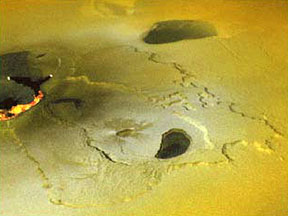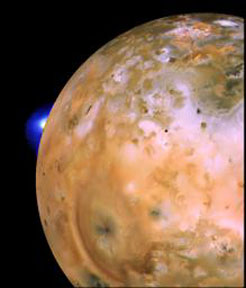Voyager photograph of Io.
Click on image for full size
Courtesy of NASA
Related links:
What is ozone?
Chlorine Found in Io Atmosphere Leads to Salt?
News story originally written on June 4, 1999
Scientists at the University of Colorado at Boulder found evidence supporting a theory that salt is present on Io. Io is one of Jupiter's many moons. Recent observations from the National Science Foundation's Kitt Peak National Observatory in Arizona led to the discovery of chlorine in Io's atmosphere.
Chlorine(Cl) along with sodium(Na) makes sodium chloride(NaCl), also known as common table salt. Salt is a very important mineral. The proportion of chlorine in Io's atmosphere is billions of times larger than Earth's. The chlorine is released into the air by huge volcanoes on the surface.
On Earth, most salt is produced when salt water evaporates. Scientists believe there may be underwater rivers on the moon producing the NaCl. It may also be produced by chemical reactions in Io's atmosphere.
Chlorine is a very important gas that breaks down ozone in Earth's atmosphere. This knowledge will help scientists understand Io's atmosphere and may eventually lead to a better understanding of our own environment.
You might also be interested in:

Minerals are the building blocks of rocks. They are non-living, solid, and, like all matter, are made of atoms of elements. There are many different types of minerals and each type is made of particular
...more
The Galileo spacecraft photographed volcanoes on the surface of Io, one of Jupiter's moons. Scientists believe there are at least 300 volcanoes on the moon. These volcanoes are somewhat different than
...more
It was another exciting and frustrating year for the space science program. It seemed that every step forward led to one backwards. Either way, NASA led the way to a great century of discovery. Unfortunately,
...more
The Space Shuttle Discovery lifted off from Kennedy Space Center on October 29th at 2:19 p.m. EST. The weather was great as Discovery took 8 1/2 minutes to reach orbit. This was the United States' 123rd
...more
A moon was discovered orbiting the asteroid, Eugenia. This is only the second time in history that a satellite has been seen circling an asteroid. A special mirror allowed scientists to find the moon
...more
Will Russia ever put the service module for the International Space Station in space? NASA officials want an answer from the Russian government. The necessary service module is currently waiting to be
...more
A coronal mass ejection (CME) happened on the Sun early last month. The material that was thrown out from this explosion passed the ACE spacecraft. The SWICS instrument on ACE has produced a new and very
...more















